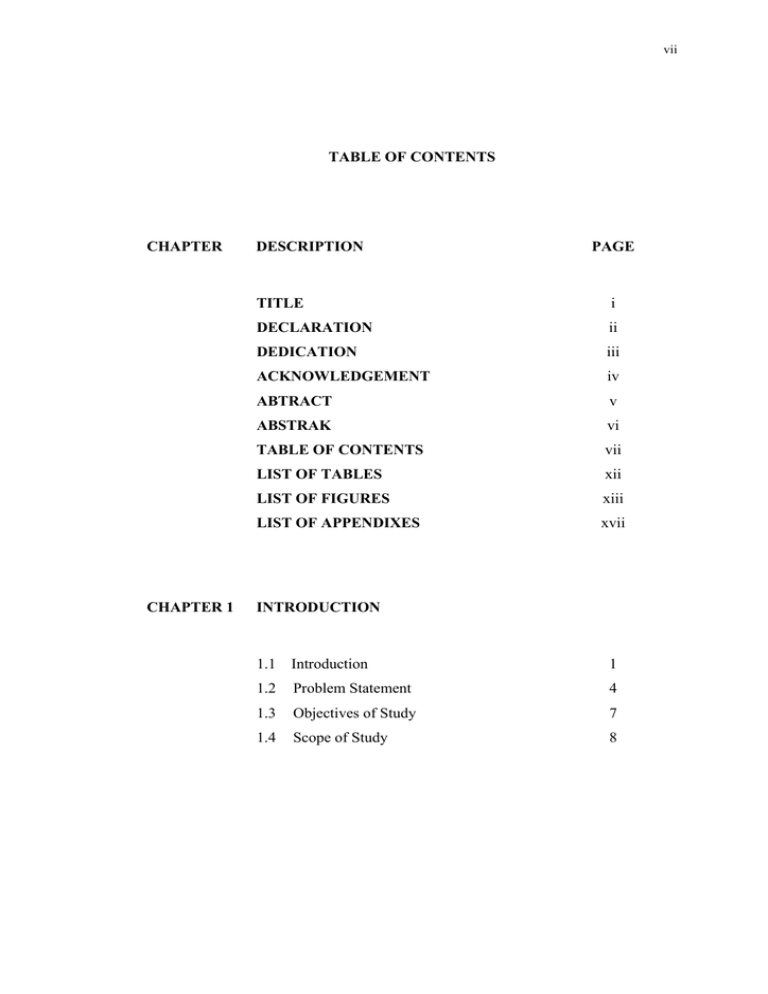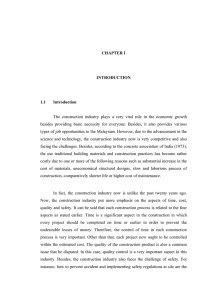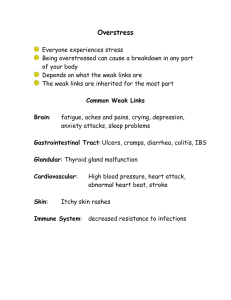TABLE OF CONTENTS CHAPTER DESCRIPTION PAGE
advertisement

vii TABLE OF CONTENTS CHAPTER CHAPTER 1 DESCRIPTION PAGE TITLE i DECLARATION ii DEDICATION iii ACKNOWLEDGEMENT iv ABTRACT v ABSTRAK vi TABLE OF CONTENTS vii LIST OF TABLES xii LIST OF FIGURES xiii LIST OF APPENDIXES xvii INTRODUCTION 1.1 Introduction 1 1.2 Problem Statement 4 1.3 Objectives of Study 7 1.4 Scope of Study 8 viii CHAPTER 2 LITERATURE REVIEW 2.1 Introduction 9 2.2 Industrialised Building System (IBS) 10 2.3 Typical classification of IBS 12 2.3.1 The frame system 14 2.3.2 Panel system 19 2.3.3 Box system 22 2.4 Classification for Types of IBS Used in Malaysia 24 2.5 The Benefits of IBS 25 2.6 Modular Coordination 27 2.7 Just-In-Time (JIT) Management in the Precast 2.8 2.9 Concrete Construction 29 Experiences Of Other Countries in IBS 32 2.8.1 The United States of America (U.S.A.) 32 2.8.2 Japan 33 2.8.3 Netherlands 34 2.8.4 Singapore 35 2.8.5 Thailand 38 2.8.6 Britain 40 2.8.7 Denmark 41 Malaysia’s own experience in IBS 41 2.10 Sequence of conventional construction method 45 2.11 Sequence of construction for IBS method 47 2.12 Scheduling of IBS components on site 49 2.12.1 Scheduling Methods 52 2.12.1.1 Microsoft Project as a Scheduling Software 2.13 IBS Scheduling for Public Buildings 53 54 ix CHAPTER 3 METHODOLOGY 3.1 Introduction 56 3.2 First stage: Identification of research topic and scope of study CHAPTER 4 56 3.3 Second stage: Data collection 58 3.4 Third stage: Results and analysis 62 3.5 Fourth stage: Make conclusion 63 DATA ANALYSIS AND DISCUSSION 4.1 Introduction 64 4.2 Background Study 65 4.3 Case Studies 66 4.3.1 Construction site: Jusco Tebrau City, Johor 66 4.3.2 Construction site: Subang USJ Mydin Wholesalers Hypermarket 4.3.3 Construction site: Kidney Dialysis Centre, Kuching 4.3.4 69 Precaster: Eastern Pretech (Malaysia) Sdn. Bhd. 70 4.3.5 Precaster: Precast Product Sdn. Bhd. 71 4.3.6 Precast Specialist Contractor: Takenaka Corporation (Malaysia) Sdn. Bhd. 4.3.7 4.3.8 4.3.9 71 Precast Specialist Contractor: Jeks Engineering Sdn. Bhd. 4.4 67 72 Precast Specialist Contractor: Pilot Construction Sdn. Bhd. 72 Jabatan Kerja Raya (JKR) 73 Rationalizing the Planning and Designing of the Proposed Conceptual IBS School 75 x 4.5 Results of Analysis 4.6 The Critical Outputs in Managing the Scheduling of Project 87 4.6.1 Time factor 87 4.6.2 Labour productivity 92 4.6.3 Task factor 96 4.7 Lifting systems 4.8 82 99 Comparative check of proposed IBS school design with Uniform Building By-Laws 1984 4.8.1 Part III: Space, Light and Ventilation – Clause 38 (1) - Width of footway 4.8.2 Clause 39 (3) – Natural Lighting and Ventilation Clause 39 (4) – Natural Lighting and Ventilation 104 Part III: Space, Light and Ventilation – Clause 43 (a) – Minimum dimensions of latrines, water-closets and bathrooms 4.8.5 104 Part III: Space, Light and Ventilation – 4.8.4 104 Part III: Space, Light and Ventilation – 4.8.3 103 105 Part III: Space, Light and Ventilation – Clause 44 (4) – Height of rooms in residential buildings, shophouses, schools, etc 105 4.8.6 Part V: Structural requirements – Clause 53 (1), (2) – Building materials 4.8.7 Part V: Structural requirements – Clause 54 (1), (2), (3) – General requirements of loading 4.8.8 106 Part V: Structural requirements – Clause 73 (1), (2) – foundations 4.8.9 105 106 Part V: Structural requirements – Clause 80 (1), (2) – Structure above foundations 106 xi CHAPTER V CONCLUSIONS AND RECOMMENDATIONS 5.1 Conclusion 108 5.2 Recommendations 112 REFERENCES 115 APPENDIXES 120 - 135 xii LIST OF TABLES TABLE NO. 2.1 TITLE Building system classification according to relative weight of component 2.2 PAGE 13 Prefabricated housing market share in Japanese Fiscal Year 1999 (April 1999-March 2000). 34 4.1 The proportion of bays for the proposed conceptual school 79 4.2 The summary for the comparisons of overall construction period for the conventional Cast-In-Situ method and precast IBS method 4.3 The approximate duration for the installation for each component 4.4 88 The total components used in the assembly of the proposed conceptual IBS school 4.5 86 97 A summary of the installation of precast components from the standard four-point picks right up to the single-point pick 102 xiii LIST OF FIGURES FIGURE NO. TITLE PAGE 1.1 The scenario of our construction industry today. 5 2.1 Frame System 12 2.2 Panel System 12 2.3 Box System 12 2.4 Examples of frame systems for industrialised buildings 14 2.5 A typical rectangular frame that consists of two precast concrete columns and a precast horizontal beam 2.6 15 Another typical rectangular frame, which consists of two columns and a horizontal beam, prefabricated using steel sections 15 2.7 Examples of frame system for multi-storey buildings 16 2.8 Two examples of frame system for public buildings 17 2.9 Examples of bracing for frame system at connection part 17 2.10 Roof materials ready to be placed on the roof frame of a typical frame system 2.11 18 Panel system solutions applied to a typical residential building 19 xiv 2.12 The support of slabs along edges on bearing wall panels 2.13 Examples of the application of hollow core slab as slab 20 panels in the building construction 21 2.14 Application of panel system as interior walls 22 2.15 The use of wall panels in the building construction 22 2.16 Arrangement of box units into position onsite 23 2.17 The sequence of installation of box system onsite 24 2.18 The JIT principle in the construction industry scenario 31 2.19 Examples of innovative IBS components produced in Singapore 2.20 The application of PLP in the construction industry in Thailand 2.21 37 39 The sources of IBS in Malaysia according to the origin of countries 42 2.22 Sequence of activities of IBS construction method 48 3.1 The flow chart of the research methodology 57 4.1 Jusco Tebrau City during construction period 67 4.2 The Subang USJ Mydin Wholesalers Hypermarket during construction period 68 4.3 One of the prestressed beams used at site 68 4.4 Kuching Kidney Dialysis Centre during construction period 69 4.5 The emblem of Eastern Pretech (Malaysia) Sdn. Bhd. 70 xv 4.6 Structural overview of the proposed conceptual school (view as per level only) 4.7 The allocation of classrooms for each 5 bays with the two offices in between each classroom 4.8 82 The scheduling of conventional construction method using Microsoft Project 4.13 81 The overall proposed conceptual school as generated in 3D modelling using ACAD software 4.12 80 The proposed conceptual school as generated in 3D modelling using ACAD software (Back View) 4.11 80 The proposed conceptual school as generated in 3D modelling using ACAD software (Front View) 4.10 78 The proposed conceptual school as generated in 3D modelling using ACAD software (Perspective View) 4.9 76 83 The scheduling of IBS method using Microsoft Project shows a significant time saving of up to 135 days compared to the conventional method 4.14 The time frame for the installation sequence of precast concrete elements at site 4.15 85 90 Delivery and unloading of structural components will only induce poorer productivity in pre-cast construction method 94 4.16 Workspace availability (congestion), work sequencing and location of work are reasons of poor productivity for both pre-cast and Cast-In-Situ construction projects 4.17 95 The types of precast components in the construction of the school 97 xvi 4.18 The lifting apparatuses used by the crane 4.19 The application of four-point picks in the construction of the proposed IBS method school 99 101 xvii LIST OF APPENDIXES APPENDIX TITLE PAGE A Gantt Chart for Conventional Method 120 B Gantt Chart for IBS Method 122 C 100 Metric Tonne Crane Specification 124 D Gantt Chart for four-point picks scheduling 128 E Gantt Chart for three-point picks scheduling 130 F Gantt Chart for two-point picks scheduling 132 G Gantt Chart for single-point picks scheduling 134




